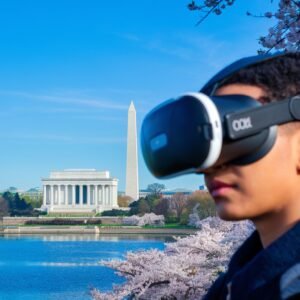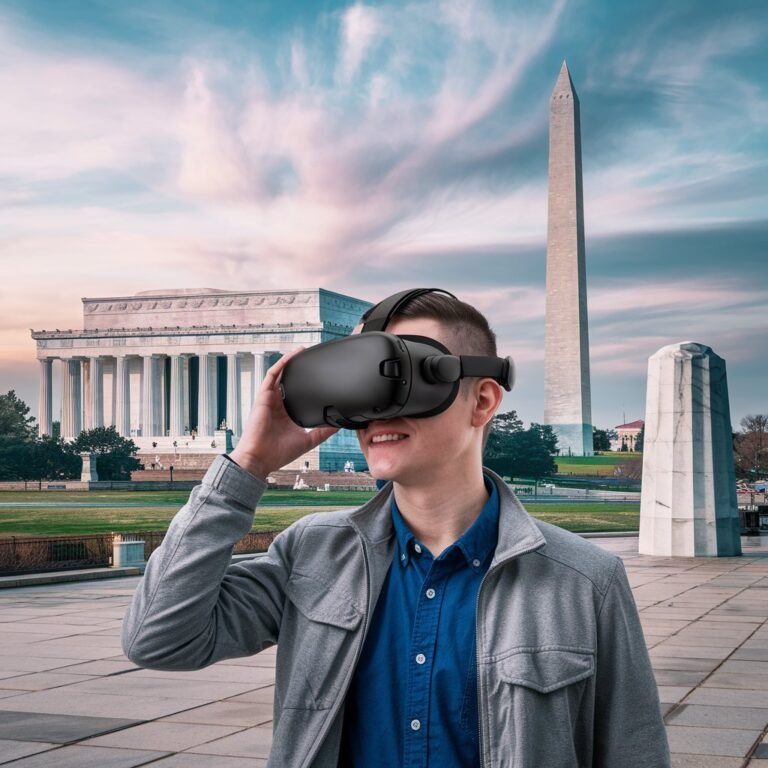Virtual reality National Mall tours are transforming the way we explore American history. Thanks to modern technology, students, teachers, and history enthusiasts can now experience the iconic monuments and memorials of the National Mall from the comfort of their own homes. This exciting virtual reality experience allows users to explore historical sites like the Lincoln Memorial, the Washington Monument, and the World War II Memorial as if they were standing right there. With just a headset, visitors can take a stroll through the heart of Washington, D.C., learning about the stories and legacies that shaped the nation.
Virtual reality National Mall programs are not just for tourists visiting Washington, D.C. They also offer a unique educational opportunity for classrooms around the country. Teachers can now bring the lessons of the National Mall directly to their students, using virtual reality to enhance lessons on U.S. history, government, and culture. This hands-on approach makes learning more interactive, allowing students to engage with history in a way that books and videos simply cannot match.
Why Virtual Reality National Mall is a Game-Changer for Education
Virtual reality National Mall is changing the way students learn about American history. Teachers can use VR to bring their lessons to life, letting students explore famous monuments and memorials up close. This new way of learning is more exciting than just reading from a book or watching a video. Students can actually feel like they are walking through history.
With virtual reality, students from any school across the country can “travel” to Washington, D.C., without leaving the classroom. They can visit important sites like the Martin Luther King Jr. Memorial or the World War II Memorial. This helps them better understand the history and significance behind these places. It makes learning fun and keeps students more engaged with the subject.
VR also provides an immersive way to teach about U.S. government and democracy. For example, students can see where important speeches were made or where historical events took place. The hands-on experience through VR technology helps them understand how history impacts their lives today.
Top Monuments You Can Visit in Virtual Reality at the National Mall

There are several important monuments you can explore in virtual reality at the National Mall. Here are a few of the most famous ones:
- Lincoln Memorial: This grand monument honors President Abraham Lincoln. In VR, you can walk up the steps and stand in front of Lincoln’s statue.
- Washington Monument: It stands tall and proud in the heart of the National Mall. With VR, you can view the monument from all angles and learn about its history.
- World War II Memorial: This memorial honors the men and women who served during WWII. The VR tour allows you to experience the beauty of the design and its deep meaning.
- Jefferson Memorial: Dedicated to President Thomas Jefferson, this beautiful monument can be fully explored in VR, including the giant statue inside.
These are just a few of the monuments you can visit. Each one comes with a guided tour filled with historical facts that help you understand the importance of each site. Virtual reality makes it possible for you to visit all these places from home or school.
How Virtual Reality National Mall Helps Students Connect with U.S. History
Virtual reality National Mall offers a powerful way for students to connect with the history of the United States. By visiting historical landmarks in a virtual world, students can experience history in a deeper, more engaging way. Rather than just reading about the Lincoln Memorial, they can walk around it, study its design, and learn why it’s significant.
Using VR technology allows students to better understand the stories behind each monument. It’s not just about memorizing dates and facts; it’s about seeing the actual places where history was made. This makes learning fun and helps students remember what they learned.
Another great thing about VR is that it helps students of all learning types. Some students are visual learners, while others learn best by doing. VR helps both groups by providing interactive, hands-on experiences that appeal to all types of learners.
Bringing the National Mall to Your Classroom: A Virtual Field Trip Experience

Virtual reality National Mall programs offer an amazing way for teachers to take their students on a virtual field trip to Washington, D.C. Without leaving the classroom, students can explore the National Mall’s famous monuments and memorials. The VR field trip allows them to gain knowledge about U.S. history while sitting at their desks.
Teachers can use the virtual tours to support lessons on history, government, and culture. VR allows students to explore places they may never have the chance to visit in person, giving them a deeper understanding of the U.S. heritage. The experience makes learning interactive and exciting, making it easier for students to engage with the material.
Why Virtual Field Trips Are Important
- Accessibility for All Students: Students with physical disabilities or financial limitations can experience the National Mall through VR.
- Affordable: Virtual field trips are much cheaper than organizing an actual field trip to Washington, D.C.
- Flexible Learning: Teachers can schedule virtual field trips at any time and pace them according to the class’s needs.
These virtual field trips are more than just fun; they are valuable educational tools that enhance learning.
The Future of Virtual Reality: National Mall Experiences Expanding Across the U.S.
As technology continues to improve, the virtual reality National Mall experience is growing. More and more schools, museums, and even homes are using VR to bring the National Mall to life. This expansion means that people who may not have been able to visit Washington, D.C., can now learn about American history in a fun, interactive way.
The future of virtual reality looks even brighter with more monuments and memorials being added to virtual tours. As VR technology improves, the experiences will become even more realistic, with better visuals, sounds, and interactive features. Soon, students from all over the country will have access to an even broader range of historical sites to explore.
Upcoming Virtual Reality Experiences
- Interactive History Lessons: Students will be able to interact with historical figures through VR.
- Expanded Monument Tours: New monuments and memorials will be added to VR platforms, giving students even more to explore.
- Global Access: More schools around the world will be able to use VR to teach American history.
Conclusion
Virtual reality National Mall is an exciting way for people to explore history without leaving their homes. It brings the famous monuments and memorials of Washington, D.C., to life through VR technology. Whether you’re a student, teacher, or just someone interested in American history, virtual reality makes learning fun and interactive. You can walk through the National Mall and experience history firsthand, all from the comfort of your own space.
As virtual reality continues to improve, more people will have access to these amazing experiences. It helps students learn about U.S. history in a way that feels real and meaningful. With more monuments being added to the virtual tours, the future of learning about the National Mall is bright. Virtual reality is truly changing how we connect with the past!
